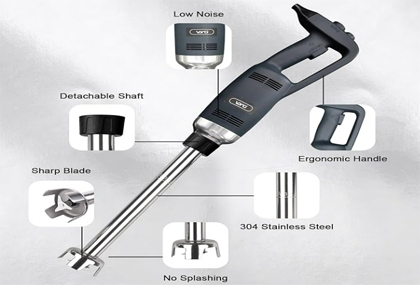Commercial Blenders: Technological Innovations Lead the New Era of Efficient Blending
Nov 28,2024
506
In modern commercial kitchens, commercial blenders play a crucial role. They not only can quickly produce various delicious drinks and foods but also bring high efficiency, convenience, and innovation to the catering industry with a series of advanced technologies.
I. Powerful power system
Commercial blenders are usually equipped with high-performance motors that can provide powerful power output. These motors are carefully designed and optimized, featuring high rotational speed and high torque. They can easily handle various hard ingredients such as ice cubes and nuts. Whether making smoothies, milkshakes, or blending thick soups, they can achieve a fine and uniform effect in a short time.
For example, the motor power of some high-end commercial blenders can reach several kilowatts and can crush and blend ingredients instantly, greatly improving work efficiency. At the same time, in order to ensure the stable operation and long service life of the motor, advanced heat dissipation technology and durable materials are also used to enable it to continuously work under high-intensity usage environments.
II. Intelligent control system
With the continuous progress of technology, commercial blenders are becoming more and more intelligent. Many commercial blenders are equipped with intelligent control systems that can achieve precise control of multiple functions.
For example, through touch screens or knobs, you can easily adjust the blending speed, time, and mode. Some blenders also have preset program functions that can automatically select the best blending parameters according to different ingredients and production needs. In addition, the intelligent control system can also monitor the working status of the blender in real time, such as motor temperature and load conditions. Once an abnormal situation occurs, it will issue an alarm in time to ensure safe use.
III. Durable materials and design
Commercial blenders need to withstand frequent use and high-intensity workloads, so their materials and designs must be highly durable.
The blending container is usually made of high-strength stainless steel, which is not only corrosion-resistant and easy to clean but also can withstand greater impact. The blades are also made of high-quality stainless steel or alloy steel, which are sharp and durable and can maintain good blending effects for a long time. In addition, the body design of commercial blenders is usually more stable, and the bottom is equipped with anti-slip pads or fixing devices to ensure that it will not shake or shift during operation.
IV. Safety protection mechanism
Safety is a crucial factor in commercial kitchens, and commercial blenders have also made a lot of efforts in this regard.
First of all, most commercial blenders are equipped with safety lock devices. Only when the blending container is correctly installed in place can the machine start. Secondly, some blenders also have overload protection functions. When the motor load is too large, it will automatically stop working to prevent motor damage. In addition, there are also safety protection measures such as splash-proof designs and emergency stop buttons to provide users with all-round safety guarantees.
V. Multifunctional applications
In addition to traditional blending functions, modern commercial blenders also have multiple other functions.
For example, some blenders can be equipped with different accessories such as egg beaters and meat grinders to achieve multi-purpose use and meet different kitchen needs. There are also some commercial blenders with heating functions that can directly make hot drinks or hot soups, providing more choices for catering enterprises.
In conclusion, commercial blenders, with their technological advantages such as powerful power systems, intelligent control systems, durable materials and designs, safety protection mechanisms, and multifunctional applications, have become indispensable equipment in commercial kitchens. With the continuous development of technology, it is believed that future commercial blenders will be more intelligent, efficient, and safe, bringing more innovation and development opportunities to the catering industry.





